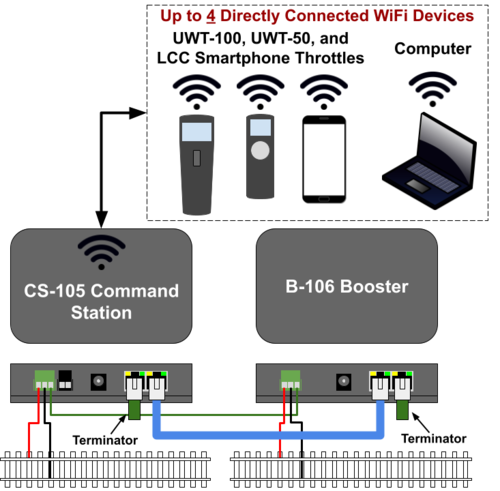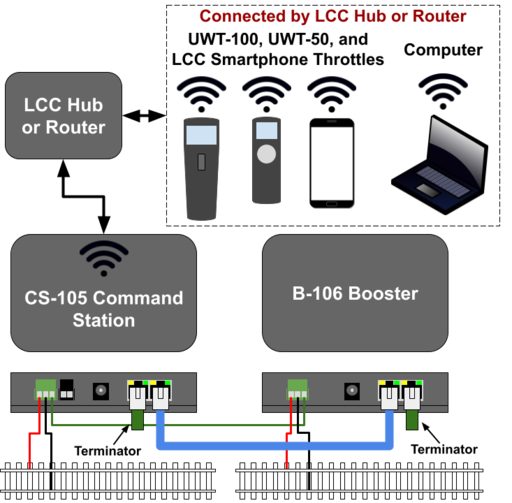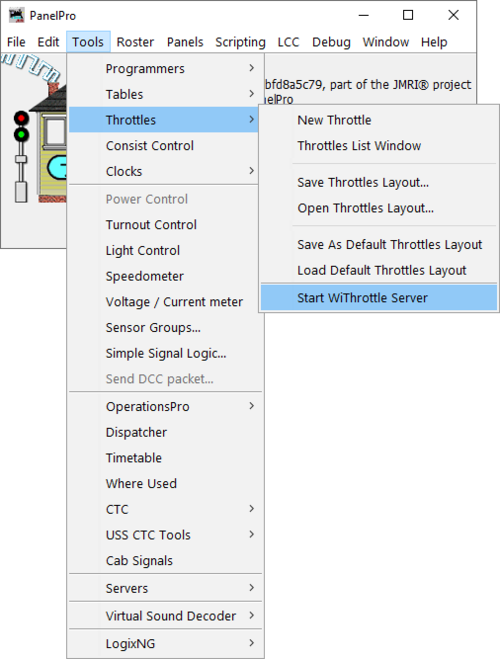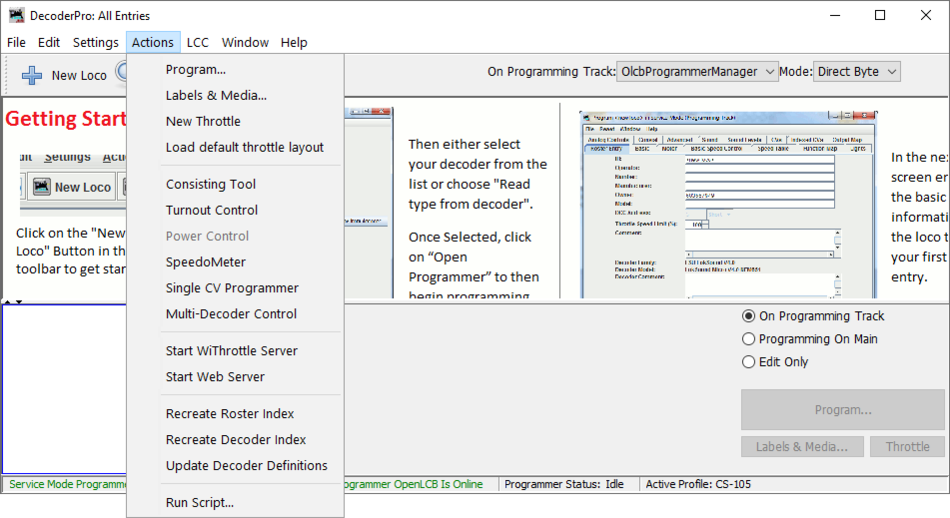CS-105
Overview
Lua error: Internal error: The interpreter exited with status 1.The CS-105 is an intelligently-designed DCC command station with LCC integration as well as a built-in RailCom® detector. Thoughtfully designed to outperform in every area, the CS-105 is the perfect DCC command station for newcomers, or layout builders or renovators looking for a highly-capable command station with the latest and greatest technology available.
The CS-105 Command Station from TCS is the new DCC standard for model railroads. This system brings a new level of operational convenience to DCC, especially when paired with a UWT-100. The CS-105 also features a wide range of new features compared to the competition. "Soft Start" as well as configurable short circuit detection for the mainline track output decreases the likelihood of burning up fouled decoders as well. Instead of spending time with your head in a manual trying to understand your system, you can consult the intuitive configuration interface of the CS-105 through a TCS throttle such as the UWT-100, allowing you to focus on the important things - operating and enjoying your trains! We are confident that the CS-105 will quickly become your favorite command station to use.
Also included in the package with the CS-105, power supply, and AC cord are two LCC terminators, detachable track power connector, and detachable programming track connector.
| This product has two Power Supply options: 12 Volts or 15 Volts
Click on one of the options below to shop: | ||
| 12V Power Supply | 15V Power Supply | |
Power Supply Selection: When selecting a power supply voltage, you choice should depend on two factors: 1) Modeling Scale 2) Maximum loco speed. For smaller scales such as Z, N, TT, etc., the 12V supply is recommended. The 12V supply is also acceptable for larger scales such as HO; however, if you like to run your trains at higher speeds the 15V supply increases the maximum voltage available to the motor, allowing your models to reach higher top speeds. This is particularly beneficial to modelers of bullet trains and other high-speed passenger services. Both power supply options are rated to supply the CS-105 with up to 5 Amperes of continuous current all day long!
Small Package; Big Power
The CS-105 is not only feature-packed, but also highly capable with plenty of horsepower for your railroad. The CS-105 has a user-configurable short circuit protection algorithm and current limit up to 5 Amperes. Unlike many systems on the market, when we say "5A continuous" we mean it! The CS-105 can supply up to 5 Amperes of current to your railroad all day and all night long. The CS-105 can also simultaneously operate up to 260 individual locomotives (consisted or solo) thanks to a highly-intelligent packet handler and "stack" management algorithm.
Auxiliary Boosters
5 Amps not enough? We understand. That's why we offer auxiliary boosters such as the B-106! Expand out your current capacity while maintaining your RailCom® network using the LCC-enabled B-106 auxiliary booster. Already have a large layout with boosters you don't want to upgrade yet? No problem! The CS-105 can be integrated into existing ecosystems such as Lenz, NCE, Digitrax, and more using our Booster Adapter (sold separately).
Multiple Connection Modes
The CS-105 can be used as a standalone access point for WiFi throttles such as the UWT-50, but can also connect to an auxiliary AP (router) to expand the network and maximum number of throttle connections. In addition to WiFi throttles, wired throttles such as the LT-50 and T-50 wired LCC throttles can be connected through the LCC Can Bus. But that's not all! The "Aux Cabs" jack on the CS-105 allows you to connect and use some other manufacturers' throttles (such as NCE, Ramtraxx, SystemOne, and more) with the CS-105. Add-on devices such as the "LCC-LocoNet Gateway" from RR-CirKits can also be used to interface Digitrax throttles and a PC.
Consisting
Consisting doesn’t have to be difficult, intimidating, or complicated! The CS-105 features a simple consisting interface where users can make, modify, and break up consists in mere seconds. The CS-105's consisting system also features new and unique configuration options for consisted engines which will make your consisting experience more realistic than ever without having to spend hours setting it up!
Full-Text Menus
The settings of the CS-105 can be accessed through a TCS throttle or JMRI. Configuration menus and options are listed in full words and phrases. No guess work or manuals needed! Use the [?] button on the TCS throttle keypad in any menu to access help text for that menu item. The throttle will display a simple description of the highlighted option. Help is always one button press away!
Easily Updatable
Field-update your software to add new features to your command station from the comfort of your own home. And don't worry, you won't lose your settings or your roster!
Specifications
DCC System
- 5 Ampere continuous current rating with soft start, configurable current limit, and load reporting
- Up to 260 locomotives and consists running simultaneously
- Up to 300 10-step Macros using both DCC and LCC accessories
- Integrated RailCom® detector on Mainline and Programming Track
- Global detector for compatible Boosters, supporting “Ops” CV reads
- Dedicated Programming Track output with automatic switchover, supporting Direct, Paged, and Register modes
Throttle Support
- Up to 4 LCC WiFi throttles via on-board WiFi Access Point (AP)
- Up to 10 LCC WiFi throttles via external WiFi Access Point (Router)
- Up to 250 LCC throttles, wired or via auxiliary LCC WiFi base stations
- Up to 62 Cab Bus (NCE wired and wireless, Ramtraxx, and SystemOne) throttles and accessories via AUX RJ-11 jack, including ISE ProtoThrottle™ and WifiTrax WFD-30/31 WiThrottle Protocol Bridge
- Up to 31 XpressNet™ (Lenz, Roco, ZTC, etc.) throttles and accessories via AUX RJ-11 jack (starting from software version 2.0)
NMRA Layout Command Control (LCC) Features
- Dual RJ-45 jack for LCC communication through CAN-bus
- 400mA output current per LCC port
- Built-in WiFi LCC computer interface
- Plain English configuration via TCS throttles or a PC
- Supports various DCC boosters connected via LCC cable
- Global RailCom® transmissions over LCC for supporting Boosters
- Firmware updates via WiFi or LCC interface
Throttle and Device Capacity
The CS-105 has several interfaces for connecting throttles and other devices. There are capacity limitations to these interfaces out-of-the-box, however the CS-105 can be paired with a number of accessories in order to expand the capacity.
This page aims to help explain the WiFi connection modes available in the CS-105, as well as the maximum number of wireless throttles (UWT-100's and or UWT-50's) that can be connected at one time in each mode.
This page also outlines the maximum number of wired throttles that can be connected to the wired throttle busses.
Wi-Fi
Autodiscovery
The CS-105 uses a standard protocol called mDNS in order for throttles to automatically connect to it when placed on the same network. Using this protocol, the CS-105 broadcasts its existence over the WiFi network so that the throttles know how to find and connect to it.
Some networks and WiFi routers block or do not support mDNS packets. In this rare case, it may become necessary to configure the CS-105 to use a static IP address and manually configure each throttle to connect using this IP address.
Access Point Mode
In this mode, the CS-105 broadcasts a WiFi SSID which supports WiFi client connection of up to four devices (throttle, PC, smart phone, etc...).
Client Mode
In this mode, the CS-105 connects to an external WiFi access point (router). It can accept connections from up to 10 other devices that are also connected to the same network.
Connecting Additional WiFi Devices
LCC Hub Connection
On its own, the CS-105 is limited to 4 WiFi connected devices in Access Point Mode and 10 WiFi connected devices in Client Mode; however, the number of connected WiFi devices can be expanded by the addition of an LCC hub. An LCC hub may be connected to the CS-105 operating in either AP Mode or Client Mode by WiFi or may be connect to the CS-105 through the LCC CAN bus (dual RJ-45 jack).
JMRI can host an LCC "Hub" on your network which LCC devices such as the UWT-100 and UWT-50 can connect to and operate the CS-105. This assumes that you have already configured a profile for JMRI to connect to your CS-105. You MUST have a JMRI version 5.4 or newer to start an LCC Hub compatible with the CS-105.
To start an LCC Hub in JMRI, follow these steps:
- Open JMRI PanelPro.
- Select the correct profile for your CS-105 connection.
- From the LCC menu, choose the Start Hub option.

- A window will open indicating that the hub has been started. JMRI also starts advertising itself to the network using mDNS so that other LCC devices can find it.
Running an LCC Hub in JMRI will enable the following possibilities:
- (Theoretically) Up to 255 simultaneous UWT connections over WiFi using Hub.
- TCS WiFi Throttles connected to the LCC Hub will have access to the LCC-only options such as the Programming Track.
How to use WiThrottle™ and Engine Driver with the CS-105
The CS-105 does not natively (by itself) support WiThrottle™ and Engine Driver throttles such as cellphones and tablets. There are two methods you can use to connect a WiThrottle - JMRI, and the WiFitrax WFD devices.
JMRI
Throttles which use the WiThrottle Protocol can be connected to the CS-105 by using JMRI and a WiThrottle Protocol server. The steps for setting this up, and features supported, are identical to any other command station.
Assuming you have already set up a profile for JMRI and your CS-105, open PanelPro and select Tools > Throttles > Start WiThrottle Server
Or open DecoderPro and select Actions > Start WiThrottle Server from the Menu.
WiFiTrax WFD
Throttles which use the WiThrottle Protocol can be connected to the CS-105 by using the WFD-30 or WFD-31 module(s) from WiFiTrax.
- Using a section of RJ-11 or RJ-12 cable, connect the WFD to the AUX Cabs port on the CS-105.
- Ensure the AUX Cabs output is in Cab Bus (NCE/Ramtraxx/SystemOne) mode.
The WFD devices will host a WiThrottle server which you can connect to from a cellphone, tablet, etc. On its own, each WFD will allow you to connect up to four WiThrottle Protocol throttles.
You can connect multiple WFD's, or use the WFD in Client Mode with a Router to expand the maximum number of WiThrottle Protocol throttles you can use at once.
LCC Throttles Over CAN Bus
The CS-105 integrates an NMRA Standard LCC CAN bus through a dual RJ-45 jack (labeled on the enclosure). This bus topology must meet the following requirements:
- Maximum length of 1000ft / 300m.
- Linear in topology with branches or T's limited to 10ft / 3m.
- Branches and T's should only be used for wired throttles.
- For each connected device, the maximum length should be reduced by 20ft / 6m. This means the practical limit [electrically] is around 48 connected devices.
- Contain exactly two terminators at the two farthest ends of the bus.
These requirements ensure reliable operation in all environments. Practically speaking, the LCC CAN bus is typically resilient to minor deviations from some of these requirements. An LCC Repeater can be used to extend the LCC CAN Bus beyond these limits. TCS recommends the RR-CirKits LCC Repeater for this purpose.
Auxiliary Throttles Bus
The CS-105 features a single RJ-12 port for connecting wired throttles for certain existing manufacturers. Two protocol modes are offered, and are mutually-exclusive, meaning only one protocol can be used at a time.
Cab Bus Mode
When running in Cab Bus mode (compatible with devices from NCE, Ramtraxx, SystemOne, and WifiTrax), there is a limit of 62 connected devices (throttles, etc...). For more information, see the Cab Bus documentation page.
XpressNET Mode
When running in XpressNet mode (compatible with devices from Lenz, Roco, ZTC, and others...), there is a limit of 31 connected devices (throttles, etc...). For more information, see the XpressNET documentation page.




